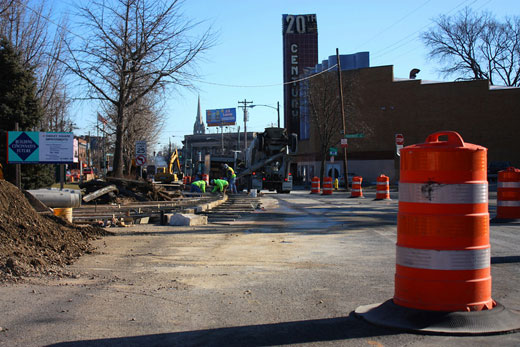
As cities work to reduce their overall environmental impact, the hardscape surfaces that make up so much of the area must also be addressed. As a result, Cincinnati officials are implementing innovative techniques to green the city's infrastructure and make a positive impact on the environment.
The Oakley Square project is one of those efforts. The new streetscaping with this project includes
pervious concrete sidewalks, gutters and pavers, as well as rain gardens and urban bioretention planters designed to reduce water runoff and the urban heat island effect. According to City officials, the redesign of the Geier Esplanade also decreases the overall amount of impervious pavement in the area while increasing the amount of greenspace.
"This is the first time
Department of Transportation & Engineering has installed pervious concrete sidewalks anywhere in the City," said Bryan Williams, Project Manager. "It was important to the community that the new streetscape be as green as possible, so we thought this would be a great opportunity to try something new."
On the other side of the city through the region's primary industrial corridor, Spring Grove Avenue is being reconstructed to accomplish similar goals. Once complete, the Spring Grove Avenue/Clifton Avenue Street Improvement Project will plant 77 new street trees and construct close to 6,000 square feet of planted rain gardens in the public right-of-way.
The rain gardens will allow for rain water to run off of the street into these natural area and then "percolate" into the ground in a way that cleans out solid pollutants from the rain water. City officials state that the rain gardens will help to reduce storm water runoff and prevent potential overflow of sanitary and first flush pollutants into the
Mill Creek waterway.
"This project is going to completely transform the street," stated Curtis Hines, Project Manager for the street reconstruction project. "Overall, the project is removing almost a half-acre of impervious area and replacing it with a consistent grass strip, trees, and landscaping."
Other projects around the city using these new practices include the construction of the new Camp Washington public plaza along Hopple Street where the City will be incorporating pervious paver systems while also using recycled granite curbs.
In the heart of Cincinnati's center city officials are working on what they call 'Green Alleys' that utilize historic clay bricks in the alleys to create a pervious pavement system after they are salvaged and cleaned. In the reconstruction process officials state that an underground storm water storage area composed of rocks and gravel is built so that the water can filter through the pavement system and be held until the ground can absorb the water naturally.
"Historic alleys of this type represent approximately 5 to 10 percent of the surface area of Over-the-Rhine and the Central Business District," stated Cincinnati's Acting City Architect Jack Martin. "Hopefully, these demonstration projects will become a prototype for similar streets and alleys in OTR and the CBD."
Writer:
Randy A. SimesPhotography by Tiffani FisherStay connected by following Randy on Twitter
@UrbanCincy
Enjoy this story?
Sign up for free solutions-based reporting in your inbox each week.